Southern Hemisphere Pressure Relationships during the 20th Century—Implications for Climate Reconstructions and Model Evaluation
Abstract
1. Introduction
2. Data and Methods
2.1. CAM5
2.2. Gridded Global Reanalyses
2.3. PCR Reconstruction Procedure and Validation
3. Results
3.1. Reconstruction Performance
3.2. Evaluating the Stationarity Constraint
4. Discussion
Author Contributions
Funding
Acknowledgments
Conflicts of Interest
References
- Gong, D.; Wang, S. Definition of Antarctic Oscillation index. Geophys. Res. Lett. 1999, 26, 459–462. [Google Scholar] [CrossRef]
- Thompson, D.W.J.; Wallace, J.M. Annular Modes in the Extratropical Circulation. Part I: Month-to-Month Variability. J. Clim. 2000, 13, 1000–1016. [Google Scholar] [CrossRef]
- Gallego, D.; Ribera, P.; Garcia-Herrera, R.; Hernandez, E.; Gimeno, L. A new look for the Southern Hemisphere jet stream. Clim. Dyn. 2005, 24, 607–621. [Google Scholar] [CrossRef]
- Rogers, J.C.; van Loon, H. Spatial Variability of Sea Level Pressure and 500 mb Height Anomalies over the Southern Hemisphere. Mon. Weather Rev. 1982, 110, 1375–1392. [Google Scholar] [CrossRef]
- Marshall, G.J. Half-century seasonal relationships between the Southern Annular mode and Antarctic temperatures. Int. J. Climatol. 2007, 27, 373–383. [Google Scholar] [CrossRef]
- Baldwin, M.P. Annular modes in global daily surface pressure. Geophys. Res. Lett. 2001, 28, 4115–4118. [Google Scholar] [CrossRef]
- Kidson, J.W. Principal Modes of Southern Hemisphere Low-Frequency Variability Obtained from NCEP–NCAR Reanalyses. J. Clim. 1999, 12, 2808–2830. [Google Scholar] [CrossRef]
- Trenberth, K.E. The Definition of El Niño. Bull. Am. Meteorol. Soc. 1997, 78, 2771–2777. [Google Scholar] [CrossRef]
- Mantua, N.J.; Hare, S.R. The Pacific Decadal Oscillation. J. Oceanogr. 2002, 58, 35–44. [Google Scholar] [CrossRef]
- Henley, B.J.; Gergis, J.; Karoly, D.J.; Power, S.; Kennedy, J.; Folland, C.K. A Tripole Index for the Interdecadal Pacific Oscillation. Clim. Dyn. 2015, 45, 3077–3090. [Google Scholar] [CrossRef]
- Enfield, D.B.; Mestas-Nuñez, A.M.; Trimble, P.J. The Atlantic Multidecadal Oscillation and its relation to rainfall and river flows in the continental U.S. Geophys. Res. Lett. 2001, 28, 2077–2080. [Google Scholar] [CrossRef]
- Revell, M.J.; Kidson, J.W.; Kiladis, G.N. Interpreting Low-Frequency Modes of Southern Hemisphere Atmospheric Variability as the Rotational Response to Divergent Forcing. Mon. Weather Rev. 2001, 129, 2416–2425. [Google Scholar] [CrossRef]
- Turner, J. The El Niño–southern oscillation and Antarctica. Int. J. Climatol. 2004, 24, 1–31. [Google Scholar] [CrossRef]
- Lachlan-Cope, T.; Connolley, W. Teleconnections between the tropical Pacific and the Amundsen-Bellinghausens Sea: Role of the El Niño/Southern Oscillation. J. Geophys. Res. Atmos. 2006, 111. [Google Scholar] [CrossRef]
- Clem, K.R.; Fogt, R.L. South Pacific circulation changes and their connection to the tropics and regional Antarctic warming in austral spring, 1979–2012: S. Pacific Trends and Tropical Influence. J. Geophys. Res. Atmos. 2015, 120, 2773–2792. [Google Scholar] [CrossRef]
- Meehl, G.A.; Arblaster, J.M.; Bitz, C.M.; Chung, C.T.Y.; Teng, H. Antarctic sea-ice expansion between 2000 and 2014 driven by tropical Pacific decadal climate variability. Nat. Geosci. 2016, 9, 590–595. [Google Scholar] [CrossRef]
- Purich, A.; England, M.H.; Cai, W.; Chikamoto, Y.; Timmermann, A.; Fyfe, J.C.; Frankcombe, L.; Meehl, G.A.; Arblaster, J.M. Tropical Pacific SST Drivers of Recent Antarctic Sea Ice Trends. J. Clim. 2016, 29, 8931–8948. [Google Scholar] [CrossRef]
- Li, X.; Holland, D.M.; Gerber, E.P.; Yoo, C. Impacts of the north and tropical Atlantic Ocean on the Antarctic Peninsula and sea ice. Nature 2014, 505, 538–542. [Google Scholar] [CrossRef]
- L’Heureux, M.L.; Thompson, D.W.J. Observed Relationships between the El Niño–Southern Oscillation and the Extratropical Zonal-Mean Circulation. J. Clim. 2006, 19, 276–287. [Google Scholar] [CrossRef]
- Fogt, R.L.; Bromwich, D.H.; Hines, K.M. Understanding the SAM influence on the South Pacific ENSO teleconnection. Clim. Dyn. 2011, 36, 1555–1576. [Google Scholar] [CrossRef]
- Wilson, A.B.; Bromwich, D.H.; Hines, K.M. Simulating the Mutual Forcing of Anomalous High Southern Latitude Atmospheric Circulation by El Niño Flavors and the Southern Annular Mode. J. Clim. 2016, 29, 2291–2309. [Google Scholar] [CrossRef]
- Gong, T.; Feldstein, S.B.; Luo, D. The Impact of ENSO on Wave Breaking and Southern Annular Mode Events. J. Atmos. Sci. 2010, 67, 2854–2870. [Google Scholar] [CrossRef]
- Gong, T.; Feldstein, S.B.; Luo, D. A Simple GCM Study on the Relationship between ENSO and the Southern Annular Mode. J. Atmos. Sci. 2013, 70, 1821–1832. [Google Scholar] [CrossRef]
- Yiu, Y.Y.S.; Maycock, A.C. On the seasonality of the El Niño teleconnection to the Amundsen Sea region. J. Clim. 2019. [Google Scholar]
- Jones, J.M.; Widmann, M. Early peak in Antarctic oscillation index. Nature 2004, 432, 290–291. [Google Scholar] [CrossRef]
- Jones, J.M.; Fogt, R.L.; Widmann, M.; Marshall, G.J.; Jones, P.D.; Visbeck, M. Historical SAM Variability. Part I: Century-Length Seasonal Reconstructions. J. Clim. 2009, 22, 5319–5345. [Google Scholar] [CrossRef]
- Visbeck, M. A Station-Based Southern Annular Mode Index from 1884 to 2005. J. Clim. 2009, 22, 940–950. [Google Scholar] [CrossRef]
- Fogt, R.L.; Goergens, C.A.; Jones, M.E.; Witte, G.A.; Lee, M.Y.; Jones, J.M. Antarctic station-based seasonal pressure reconstructions since 1905: 1. Reconstruction evaluation: Antarctic Pressure Evaluation. J. Geophys. Res. Atmos. 2016, 121, 2814–2835. [Google Scholar] [CrossRef]
- Fogt, R.L.; Jones, J.M.; Goergens, C.A.; Jones, M.E.; Witte, G.A.; Lee, M.Y. Antarctic station-based seasonal pressure reconstructions since 1905: 2. Variability and trends during the twentieth century. J. Geophys. Res. Atmos. 2016, 121, 2836–2856. [Google Scholar] [CrossRef]
- Miller, R.L.; Schmidt, G.A.; Shindell, D.T. Forced annular variations in the 20th century Intergovernmental Panel on Climate Change Fourth Assessment Report models. J. Geophys. Res. 2006, 111. [Google Scholar] [CrossRef]
- Fogt, R.L.; Perlwitz, J.; Monaghan, A.J.; Bromwich, D.H.; Jones, J.M.; Marshall, G.J. Historical SAM Variability. Part II: Twentieth-Century Variability and Trends from Reconstructions, Observations and the IPCC AR4 Models. J. Clim. 2009, 22, 5346–5365. [Google Scholar] [CrossRef]
- Fogt, R.L.; Goergens, C.A.; Jones, J.M.; Schneider, D.P.; Nicolas, J.P.; Bromwich, D.H.; Dusselier, H.E. A twentieth century perspective on summer Antarctic pressure change and variability and contributions from tropical SSTs and ozone depletion. Geophys. Res. Lett. 2017, 44, 9918–9927. [Google Scholar] [CrossRef]
- Fogt, R.L.; Schneider, D.P.; Goergens, C.A.; Jones, J.M.; Clark, L.N.; Garberoglio, M.J. Seasonal Antarctic pressure variability during the twentieth century from spatially complete reconstructions and CAM5 simulations. Clim. Dyn. 2019, 1–18. [Google Scholar] [CrossRef]
- Polvani, L.M.; Waugh, D.W.; Correa, G.J.P.; Son, S.W. Stratospheric Ozone Depletion: The Main Driver of Twentieth-Century Atmospheric Circulation Changes in the Southern Hemisphere. J. Clim. 2011, 24, 795–812. [Google Scholar] [CrossRef]
- Thompson, D.W.J.; Solomon, S. Interpretation of Recent Southern Hemisphere Climate Change. Science 2002, 296, 895–899. [Google Scholar] [CrossRef]
- Mann, M.E. Climate Over the Past Two Millennia. Annu. Rev. Earth Planet. Sci. 2007, 35, 111–136. [Google Scholar] [CrossRef]
- Turner, J.; Colwell, S.R.; Marshall, G.J.; Lachlan-Cope, T.A.; Carleton, A.M.; Jones, P.D.; Lagun, V.; Reid, P.A.; Iagovkina, S. The SCAR READER project: Toward a high-quality database of mean Antarctic meteorological observations. J. Clim. 2004, 17, 2890–2898. [Google Scholar] [CrossRef]
- Marshall, G.J.; Bracegirdle, T.J. An examination of the relationship between the Southern Annular Mode and Antarctic surface air temperatures in the CMIP5 historical runs. Clim. Dyn. 2015, 45, 1513–1535. [Google Scholar] [CrossRef]
- Hosking, J.S.; Orr, A.; Marshall, G.J.; Turner, J.; Phillips, T. The Influence of the Amundsen–Bellingshausen Seas Low on the Climate of West Antarctica and Its Representation in Coupled Climate Model Simulations. J. Clim. 2013, 26, 6633–6648. [Google Scholar] [CrossRef]
- Turner, J.; Bracegirdle, T.J.; Phillips, T.; Marshall, G.J.; Hosking, J.S. An Initial Assessment of Antarctic Sea Ice Extent in the CMIP5 Models. J. Clim. 2013, 26, 1473–1484. [Google Scholar] [CrossRef]
- Jones, J.M.; Gille, S.T.; Goosse, H.; Abram, N.J.; Canziani, P.O.; Charman, D.J.; Clem, K.R.; Crosta, X.; de Lavergne, C.; Eisenman, I.; et al. Assessing recent trends in high-latitude Southern Hemisphere surface climate. Nat. Clim. Change 2016, 6, 917–926. [Google Scholar] [CrossRef]
- Bracegirdle, T.J.; Colleoni, F.; Abram, N.J.; Bertler, N.A.N.; Dixon, D.A.; England, M.; Favier, V.; Fogwill, C.J.; Fyfe, J.C.; Goodwin, I.; et al. Back to the Future: Using Long-Term Observational and Paleo-Proxy Reconstructions to Improve Model Projections of Antarctic Climate. Geosciences 2019, 9, 255. [Google Scholar] [CrossRef]
- Schneider, D.P.; Fogt, R.L. Artifacts in Century-Length Atmospheric and Coupled Reanalyses Over Antarctica Due To Historical Data Availability. Geophys. Res. Lett. 2018, 45, 964–973. [Google Scholar] [CrossRef]
- Fogt, R.L.; Clark, L.N.; Nicolas, J.P. A New Monthly Pressure Dataset Poleward of 60° S since 1957. J. Clim. 2018, 31, 3865–3874. [Google Scholar] [CrossRef]
- England, M.R.; Polvani, L.M.; Smith, K.L.; Landrum, L.; Holland, M.M. Robust response of the Amundsen Sea Low to stratospheric ozone depletion: OZONE EFFECT ON THE ASL. Geophys. Res. Lett. 2016, 43, 8207–8213. [Google Scholar] [CrossRef]
- Raphael, M.N.; Marshall, G.J.; Turner, J.; Fogt, R.L.; Schneider, D.; Dixon, D.A.; Hosking, J.S.; Jones, J.M.; Hobbs, W.R. The Amundsen Sea Low: Variability, Change and Impact on Antarctic Climate. Bull. Am. Meteorol. Soc. 2016, 97, 111–121. [Google Scholar] [CrossRef]
- Compo, G.P.; Whitaker, J.S.; Sardeshmukh, P.D.; Matsui, N.; Allan, R.J.; Yin, X.; Gleason, B.E.; Vose, R.S.; Rutledge, G.; Bessemoulin, P.; et al. The Twentieth Century Reanalysis Project. Q. J. R. Meteorol. Soc. 2011, 137, 1–28. [Google Scholar] [CrossRef]
- Poli, P.; Hersbach, H.; Dee, D.P.; Berrisford, P.; Simmons, A.J.; Vitart, F.; Laloyaux, P.; Tan, D.G.H.; Peubey, C.; Thépaut, J.N.; et al. ERA-20C: An Atmospheric Reanalysis of the Twentieth Century. J. Clim. 2016, 29, 4083–4097. [Google Scholar] [CrossRef]
- Laloyaux, P.; Thépaut, J.N.; Dee, D. Impact of Scatterometer Surface Wind Data in the ECMWF Coupled Assimilation System. Mon. Weather Rev. 2016, 144, 1203–1217. [Google Scholar] [CrossRef]
- Cram, T.A.; Compo, G.P.; Yin, X.; Allan, R.J.; McColl, C.; Vose, R.S.; Whitaker, J.S.; Matsui, N.; Ashcroft, L.; Auchmann, R.; et al. The International Surface Pressure Databank version 2. Geosci. Data J. 2015, 2, 31–46. [Google Scholar] [CrossRef]
- Woodruff, S.D.; Worley, S.J.; Lubker, S.J.; Ji, Z.; Eric Freeman, J.; Berry, D.I.; Brohan, P.; Kent, E.C.; Reynolds, R.W.; Smith, S.R.; et al. ICOADS Release 2.5: Extensions and enhancements to the surface marine meteorological archive. Int. J. Climatol. 2011, 31, 951–967. [Google Scholar] [CrossRef]
- Bromwich, D.H.; Nicolas, J.P.; Monaghan, A.J. An Assessment of Precipitation Changes over Antarctica and the Southern Ocean since 1989 in Contemporary Global Reanalyses. J. Clim. 2011, 24, 4189–4209. [Google Scholar] [CrossRef]
- Bracegirdle, T.J.; Marshall, G.J. The Reliability of Antarctic Tropospheric Pressure and Temperature in the Latest Global Reanalyses. J. Clim. 2012, 25, 7138–7146. [Google Scholar] [CrossRef]
- Cook, E.R.; Meko, D.M.; Stahle, D.W.; Cleaveland, M.K. Drought reconstructions for the continental United States. J. Clim. 1999, 12, 1145–1162. [Google Scholar] [CrossRef]
- Thompson, D.W.J.; Solomon, S.; Kushner, P.J.; England, M.H.; Grise, K.M.; Karoly, D.J. Signatures of the Antarctic ozone hole in Southern Hemisphere surface climate change. Nat. Geosci. 2011, 4, 741–749. [Google Scholar] [CrossRef]
- Stolarski, R.S.; Douglass, A.R.; Gupta, M.; Newman, P.A.; Pawson, S.; Schoeberl, M.R.; Nielsen, J.E. An ozone increase in the Antarctic summer stratosphere: A dynamical response to the ozone hole. Geophys. Res. Lett. 2006, 33. [Google Scholar] [CrossRef]
- Trenberth, K.E.; Smith, L. The Mass of the Atmosphere: A Constraint on Global Analyses. J. Clim. 2005, 18, 864–875. [Google Scholar] [CrossRef]
- Marshall, G.J. Trends in the southern annular mode from observations and reanalyses. J. Clim. 2003, 16, 4134–4143. [Google Scholar] [CrossRef]
- Neukom, R.; Gergis, J.; Karoly, D.J.; Wanner, H.; Curran, M.; Elbert, J.; González-Rouco, F.; Linsley, B.K.; Moy, A.D.; Mundo, I.; et al. Inter-hemispheric temperature variability over the past millennium. Nat. Clim. Chang. 2014, 4, 362–367. [Google Scholar] [CrossRef]
- Stenni, B.; Curran, M.A.J.; Abram, N.J.; Orsi, A.; Goursaud, S.; Masson-Delmotte, V.; Neukom, R.; Goosse, H.; Divine, D.; van Ommen, T.; et al. Antarctic climate variability on regional and continental scales over the last 2000 years. Clim. Past 2017, 13, 1609–1634. [Google Scholar] [CrossRef]
- Connolley, W.M. Variability in annual mean circulation in southern high latitudes. Clim. Dyn. 1997, 13, 745–756. [Google Scholar] [CrossRef]
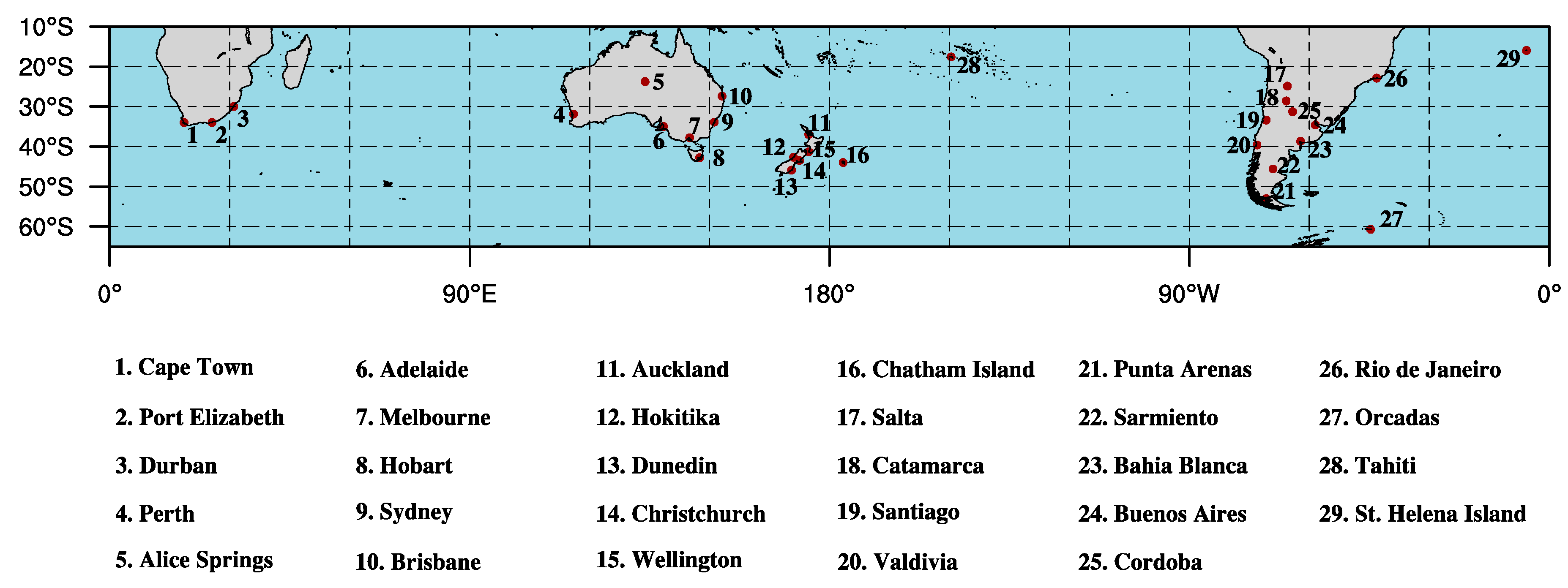
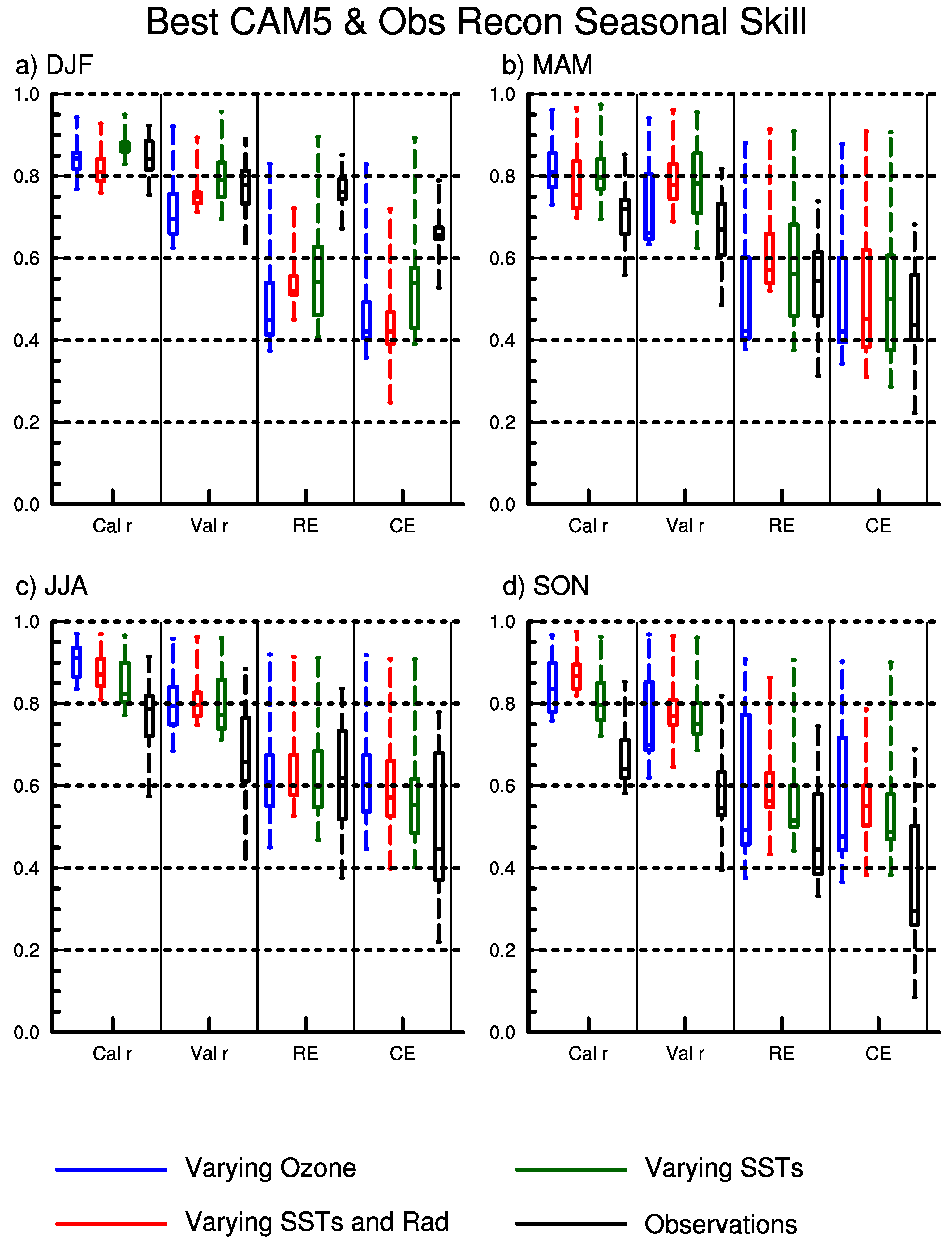
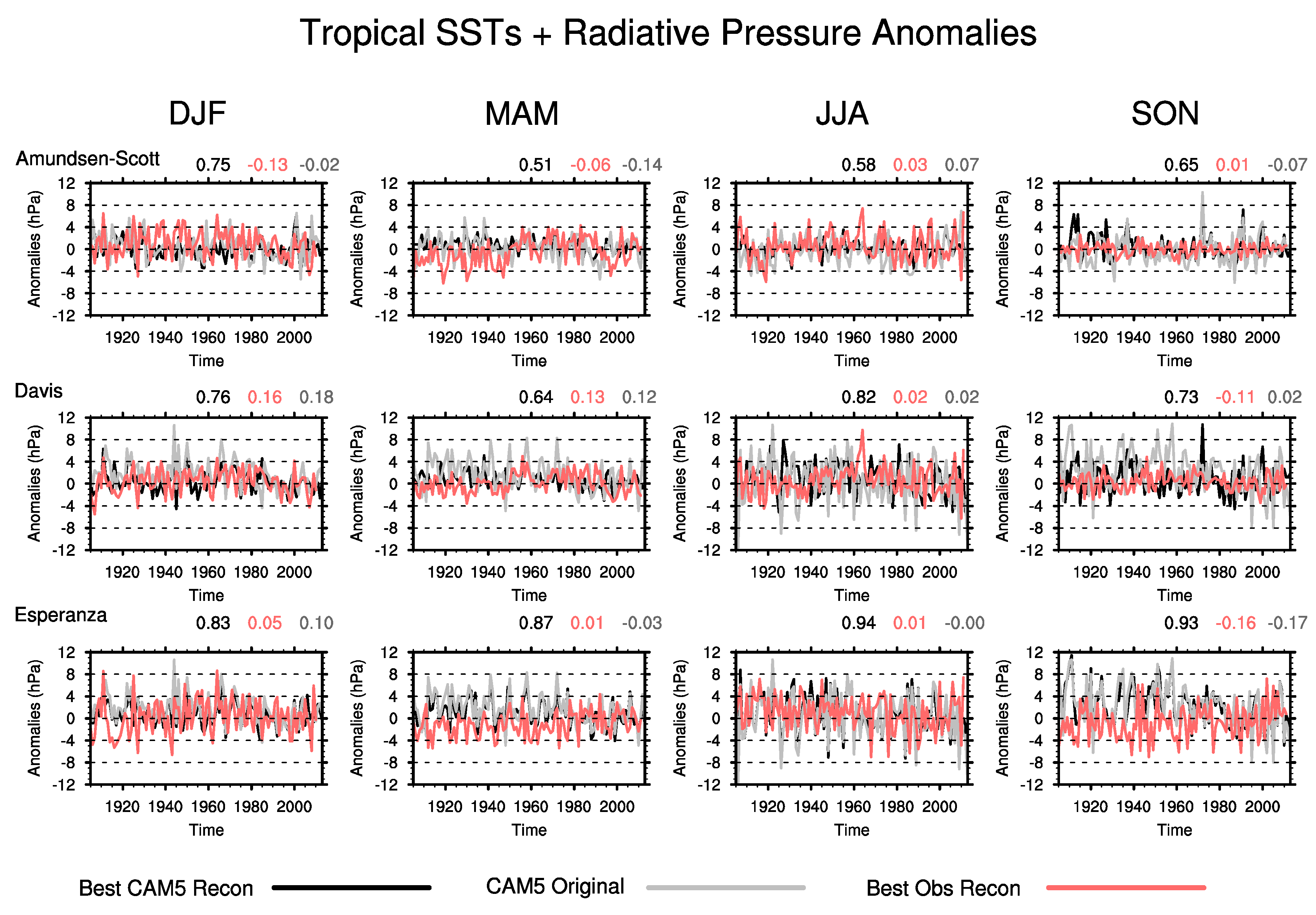
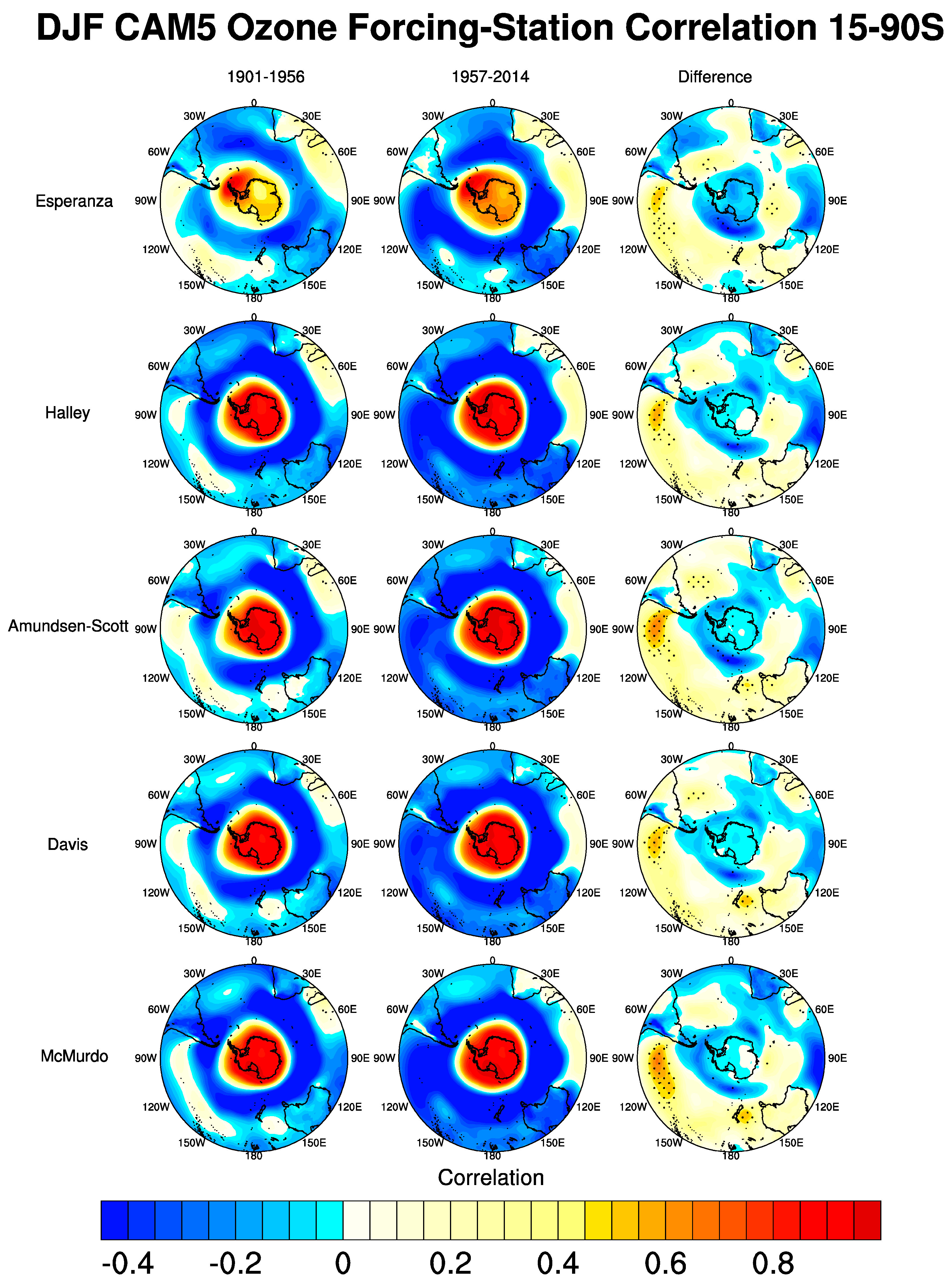
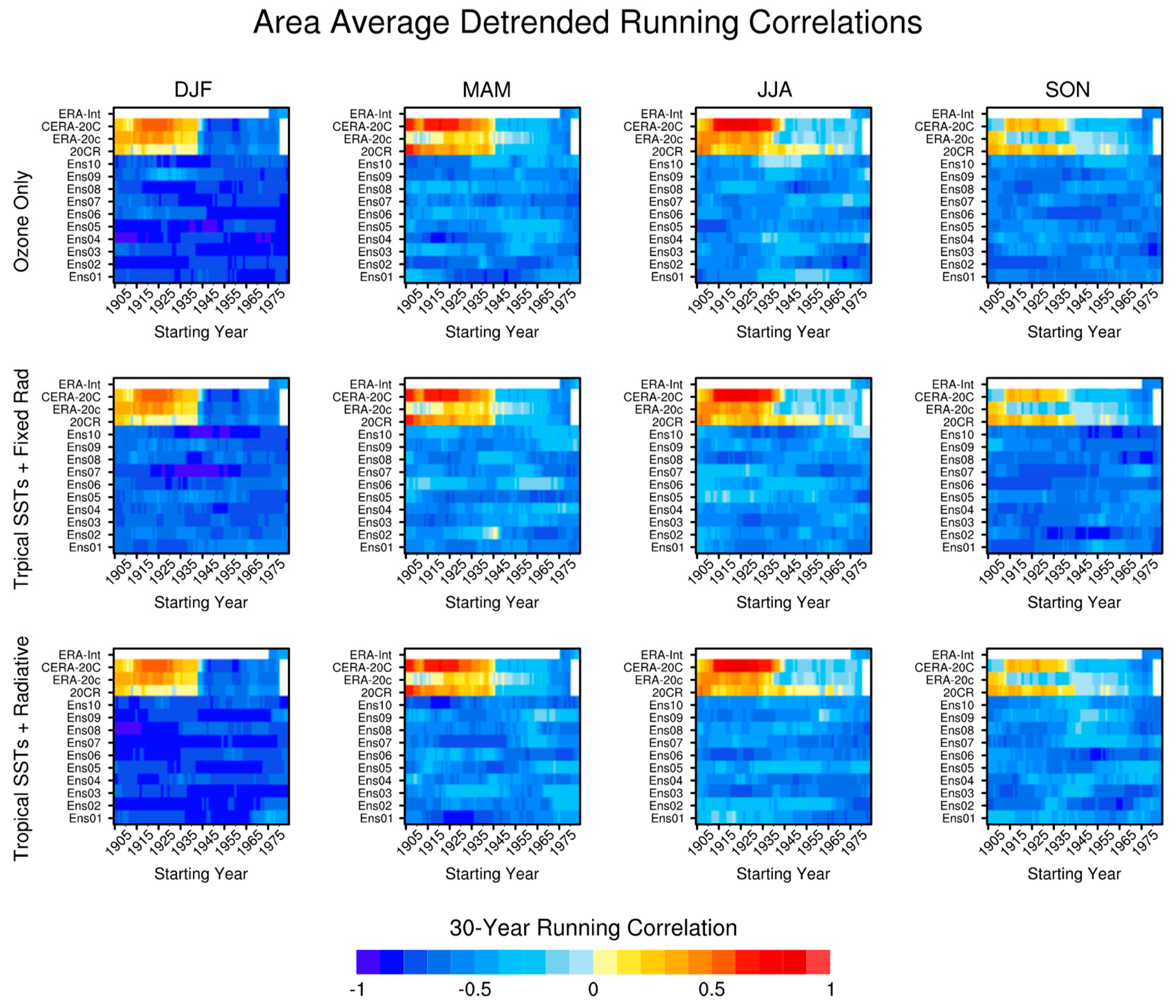
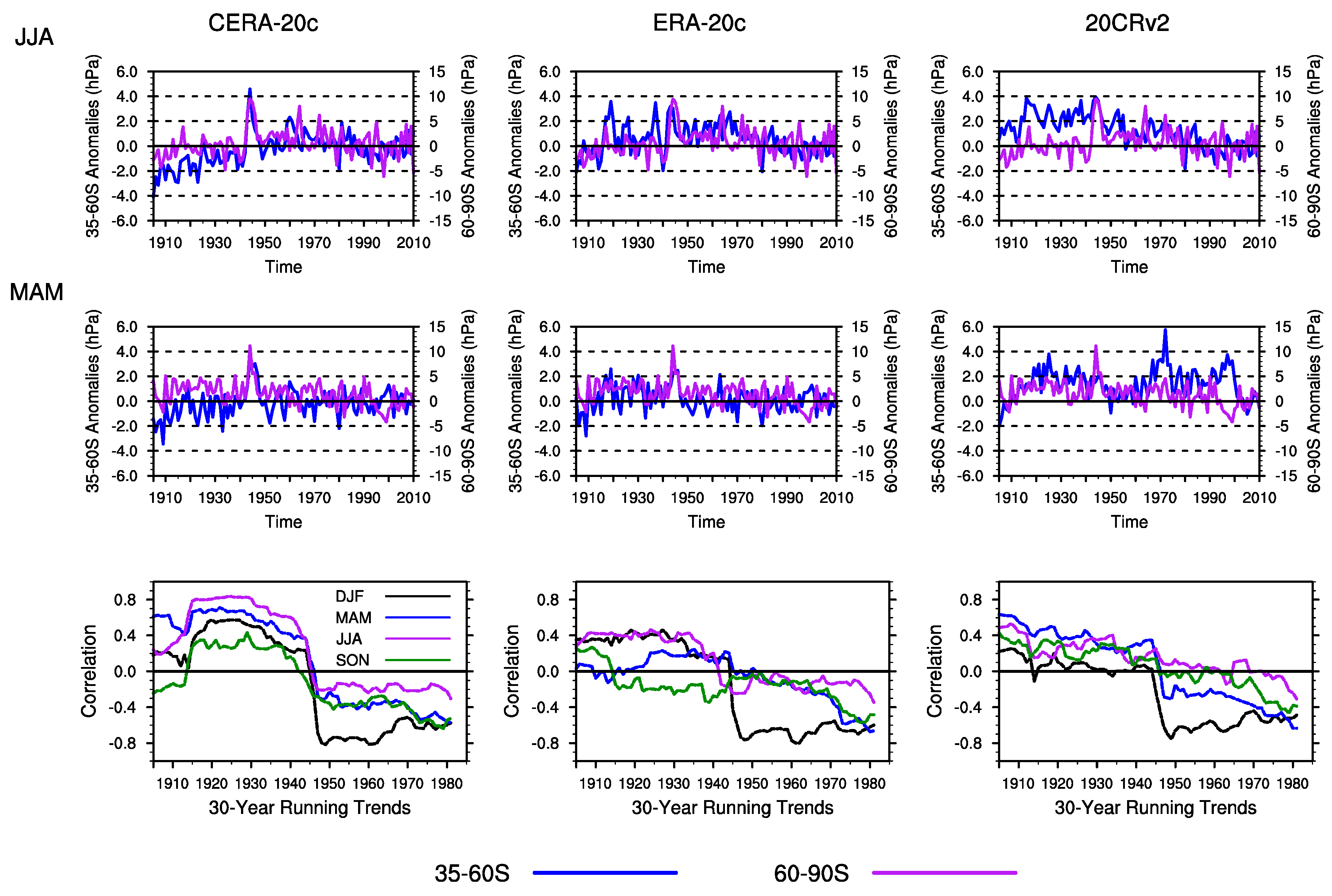
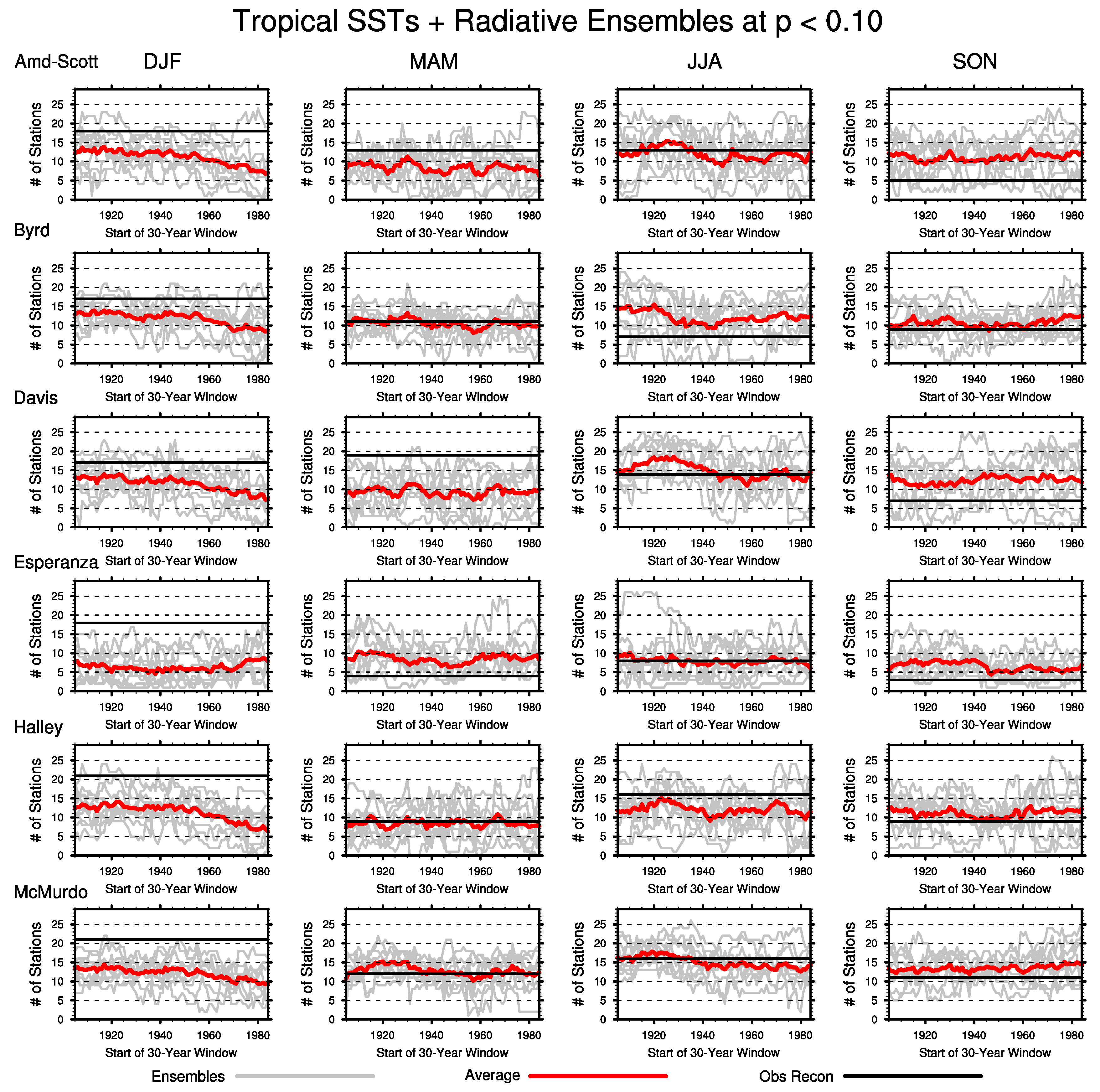
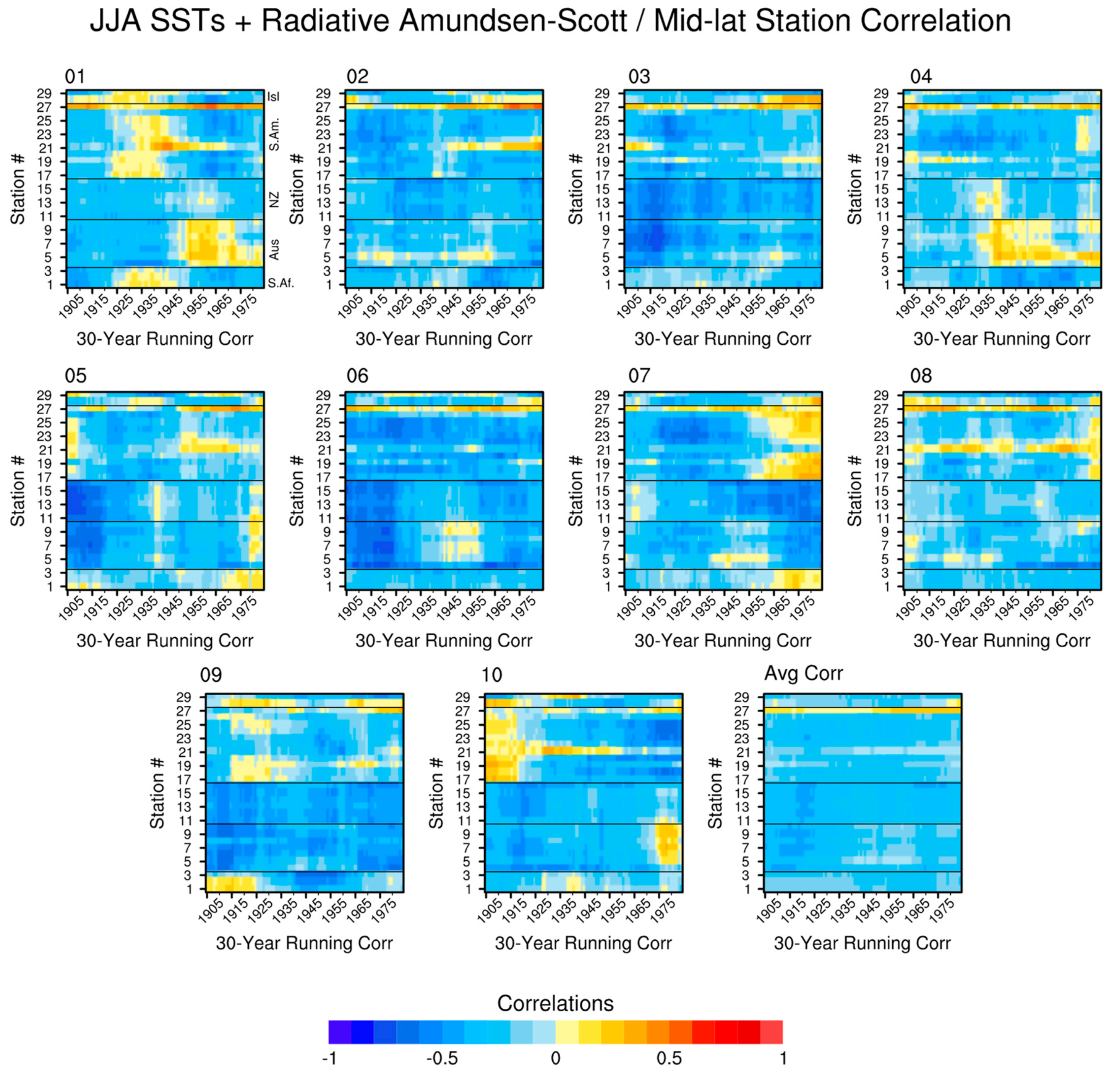
| CAM5 Experiment | Time Period (Years) | Forcing(s) |
|---|---|---|
| 1. Ozone Only | 1900–2014 | Ozone (O3) Time-varying ozone concentrations |
| 2. Tropical SSTs + Fixed Radiative | 1874–2014 | SSTs (28° N–28° S) Time-varying tropical SSTs |
| 3. Tropical SSTs + Radiative | 1880–2014 | SSTs (28° N–28° S) Time-varying tropical SSTs and all radiative forcings |
© 2019 by the authors. Licensee MDPI, Basel, Switzerland. This article is an open access article distributed under the terms and conditions of the Creative Commons Attribution (CC BY) license (http://creativecommons.org/licenses/by/4.0/).
Share and Cite
Clark, L.; Fogt, R. Southern Hemisphere Pressure Relationships during the 20th Century—Implications for Climate Reconstructions and Model Evaluation. Geosciences 2019, 9, 413. https://doi.org/10.3390/geosciences9100413
Clark L, Fogt R. Southern Hemisphere Pressure Relationships during the 20th Century—Implications for Climate Reconstructions and Model Evaluation. Geosciences. 2019; 9(10):413. https://doi.org/10.3390/geosciences9100413
Chicago/Turabian StyleClark, Logan, and Ryan Fogt. 2019. "Southern Hemisphere Pressure Relationships during the 20th Century—Implications for Climate Reconstructions and Model Evaluation" Geosciences 9, no. 10: 413. https://doi.org/10.3390/geosciences9100413
APA StyleClark, L., & Fogt, R. (2019). Southern Hemisphere Pressure Relationships during the 20th Century—Implications for Climate Reconstructions and Model Evaluation. Geosciences, 9(10), 413. https://doi.org/10.3390/geosciences9100413




